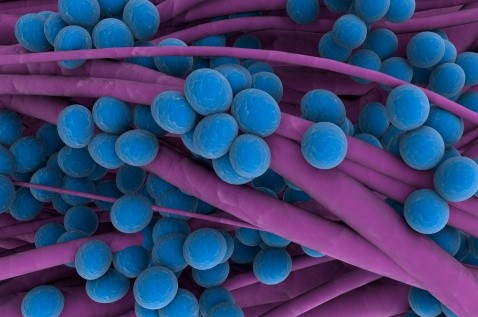Why so persistent?

Persistence — it’s what keeps us all surviving. If it weren’t for this lovely quality, we’d just give up and crawl under a rock somewhere because it’s all just so darn difficult out there in the world. Same’s true for every bacterial infection we know of, the chronic ones in particular. Persistence is paramount. Think about it: we humans do everything we can to get rid of these ferocious microbes, but try as we may, many of them just refuse to die. It’s one of the most pressing issues in public health today. From biofilms on medical devices to the ever-dreaded staph infection, several persistent bacterial infections elude current medical wisdom.
Earlier in his career, Kim Lewis of the College of Science showed that a select few bacterial cells stick around after antibiotic onslaught even though they are genetically identical to their not-so-lucky compatriots that succumb. Lewis has dedicated his life to figuring out what makes these persister cells, as they’re called, so good at surviving. Since most antibiotics work by disrupting active processes of cellular function, it seems as though persistence is akin to dormancy. For instance, if a cell isn’t making DNA because it’s “asleep,” then a drug that works by interfering with DNA production and causing damage won’t have any impact on that particular cell. What sends a cell into dormancy remains a mystery, though. About a decade ago Lewis’ team showed that pairs of bacterial proteins called toxin/antitoxin pairs seem to mediate dormancy by stopping and starting cell growth at various points.
A few years later, the team identified a specific toxin/antitoxin pair that can be induced when a certain class of antibiotics, called fluoroquinolones, comes on the scene. “It’s very clever,” said Iris Keren, a senior research scientist in the Lewis lab. “If you treat a patient with fluorquinolones, yes you kill a lot of bacteria, but at the same time you actually help them generate more persistors.” Fluoroquinolones act by damaging bacterial DNA, a pretty stressful situation for the bugs. Another form of stress that’s particularly difficult for bacteria is called oxidative stress. When bad bacteria get into the body, the immune system responds by sending a macrophage to eat them up in big gulps. When the macrophages see their dinner, they start sending out so-called “reactive oxygen species” and “reactive nitrogen species.” The bacteria respond with their own global defense system, eliminating the reactive species and trying to repair damage. It seemed reasonable to think that such a response may also cause some of the cells to go into dormancy and become persisters. So, they hit the bench.
First, they exposed bacterial cultures to a compound called paraquat, which causes oxidative stress similar to macrophages. Then they tried to kill the bacteria with three different antibiotics, one of which was a fluoroquinolone (oflaxacin to be specific). The other two were ampicillin, which is a type of beta-lactam and works by preventing proper cell wall synthesis, and kanamycin, an aminoglycoside which affect protein synthesis causing the generation of aberrant toxic proteins.
The researchers were surprised by their results: The number of persister cells in the culture did spike after oxidative stress — but only in the case of one of the three drugs: the fluoroquinolone. Oxidative stress had no affect on persister levels in the case of the other two antibiotics. Clearly, something else was going on.. The team decided to take a closer look at the persister cells that came out of the fluorquinolone exposure experiment. It turned out these cells were now not just tolerant to that drug, they were also tolerant to both ampicillin and kanamycin. So cells that were treated with paraquat and than with ofloxacin were now tolerant to all three antibiotics.
Before we keep going, we first need to understand why the fluorquinolone behaved differently that the other antibiotics. Paraquot (the compound used to cause oxidative stress) also induces something called a multidrug resistant (MDR) pump. It’s a type of protein that resides in the cell wall and is capable of pumping out different kinds of drugs that make their way into the cell. While it does work on different types of drugs, it has no affect on beta-lactams or aminoglyosides. Of the three antibiotic types that the team threatened their little bacterial cultures with, only the fluorquinolones were actively removed by the MDR pump. This is classic antibiotic resistance. The bacteria is presented with something that’s trying to kill it and it actively sweeps that toxin out of the house.
Persistence is much different. Those cells that happen to be in a dormant state for one reason or another tolerate all antibiotics they’re attacked with. When they wake back up, if the antibiotic is still around the persisters will indeed die. But if the antibiotic is gone, sweet! They can rekindle their lifelong dream of reproduction.
So, first the oxidative stress turned on the MDR pump, which made it resistant to the fluoroquinolone. Then, exposure to that drug sent most of the cells into a dormant state which protected them from the other antibiotic, explained Keren. “This is an interesting finding,” said Keren, because we now get into this intersection between persisters and resistance.”
Under normal conditions, persisters are still a problem, but this series of events increased the number of persisters around. While the work is invaluable in helping researchers to understand a little more about how persistence works, it could also prove a useful tool for further study. One of the biggest issues in studying persister cells is their relative obscurity. In a colony of bacteria, only a small fraction are usually persisters so isolating them and studying them is difficult. But with protocols such as this to induce persistence, researchers have more to work with.
